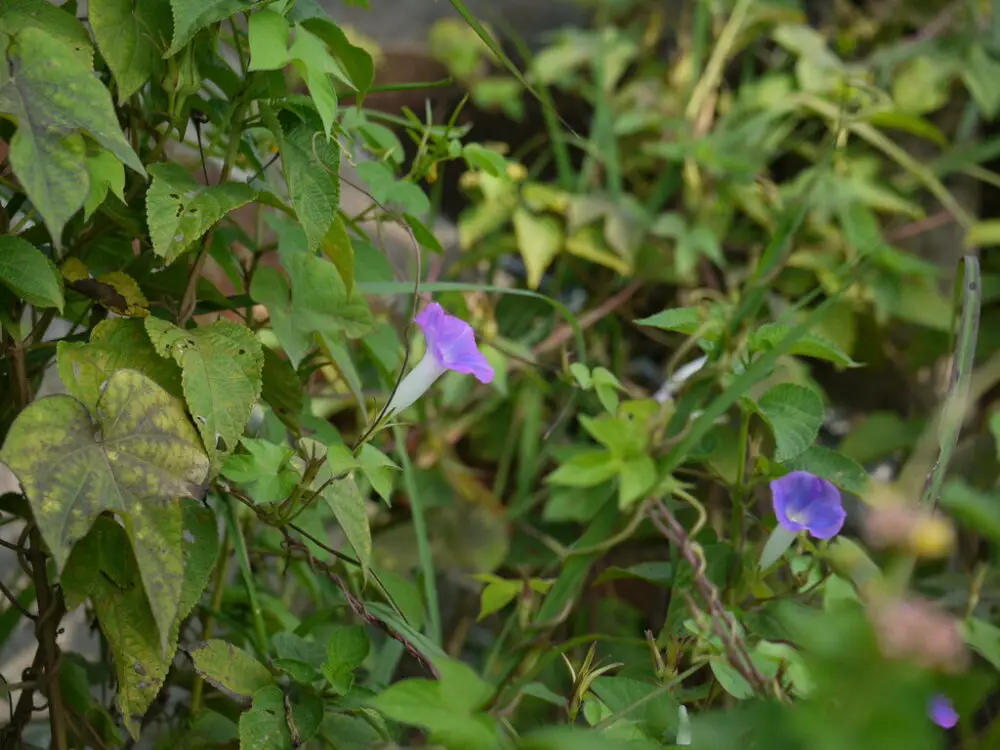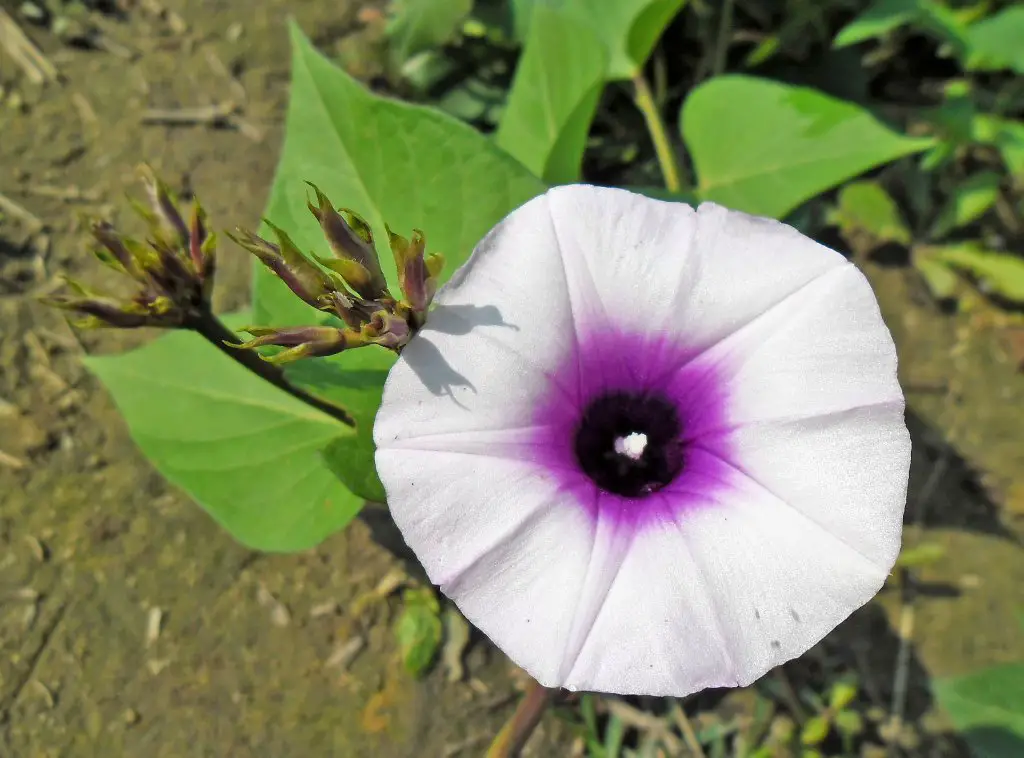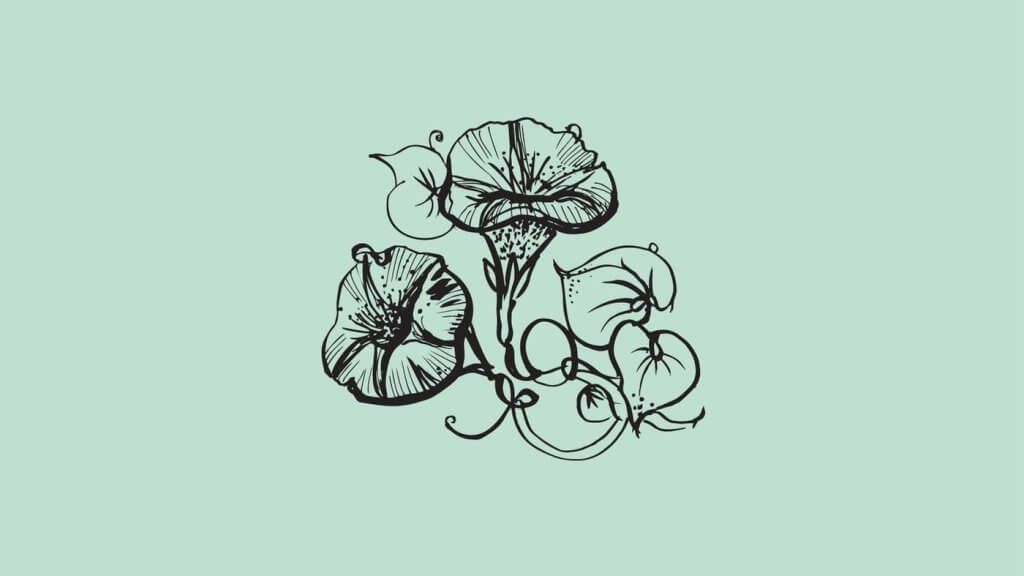Ipomoea nil is an ornamental plant with beautiful blue flowers. The flowers open in the morning and close in the afternoon. Be careful where you plant I. nil. It is a fast-growing climber, and the seeds can be toxic to humans and animals. Luckily, most animals don’t seem particularly attracted to this plant.
Ipomoea Nil Plant Profile
From the Convolvulaceae family, this invasive tropical plant is quite a spectacle and easy to grow. The Ipomoea genus is the largest in the Convolvulaceae family. Even though it is commonly referred to as Japanese morning glory, it is not native to Japan.
The current-day scientific name for this plant is Ipomoea nil. However, there are many synonyms and common names, including:
- Convolvulus nil
- Convolvulus hederaceus
- Ipomoea githaginea (Hochst)
- Ipomoea scabra (Forssk)
- Pharbitis nil (Choisy)
- Scarlett O’Hara
- Grandpa ott
- Picotee morning glory
- Blue morning glory
- White edge morning glory
- Japanese morning glory
Ipomoea Nil Identification
While the wild forms of this plant are almost always blue with a white throat (sometimes with a hint of pink), cultivated forms can be found in different colors. All forms of the flower are round and trumpet-shaped.
What Are You Foraging For Right Now?
We're thrilled to hear your ideas. What would you like to submit today? Feel free to share your thoughts and experiences with us.
To spot this specific herbaceous species, you’ll need to investigate the plant closely. The hairy, elongated sepals that protect the flower do not curve at the tips.
The seedpods always point upwards. It has a hairy stem with emerald-green heart-shaped leaves.

Is Morning Glory the Same as Ipomoea Nil?
Ipomoea nil is a species of Ipomoea morning glory. Many people lump all of the morning glories together, but that is a mistake.
According to the plants’ database, there are up to 600 different species of vines and shrubs in the Ipomoea genus.
A few other common types of morning glories include:
Ipomoea purpurea: As you may guess from the name, this species is purple. I. purpurea has short sepals with a wide base. Unlike I. nil, the seedpods turn downwards after fertilization.
Ipomoea hederacea (Jacq): This species is also known as ivy morning glory. It can be differentiated from I. nil by its backward curved sepals.
Ipomoea alba: Also known as moonflower, I. alba opens at night. The flower is white with a pale green throat and dark green leaves.
Ipomoea indica: This species, also known as the blue dawn flower, could cause a skin rash if you are exposed to it for too long. Its flowers are larger than n, measuring about five inches long.
Ipomoea tricolor: Also known as heavenly blue, this species has short pointy sepals. It can be blue, pink, or white and has short, pointed sepals that hug the base of the flower and seedpod.
Where Does I. Nil Grow?
Scarlett O’Hara is native to the tropical and subtropical Americas, including Central America and Mexico.
However, it has been cultivated extensively and is easy to find in many places and habitats worldwide, especially in Asia.
This twining annual or perennial uses its stems to invade other plants as it climbs vertically towards the sun. As a result, it thrives in USDA hardiness zones 8-11.
Japanese morning glory is considered an invasive plant in many parts of the world, not including the United States.

Is Ipomoea Nil Poisonous?
This plant species is poisonous to humans and animals if they eat the seeds.
The hallucinogenic seeds can cause kidney damage, vomiting, diarrhea, and abdominal pain.
Can You Eat Ipomoea Nil?
I. nil is not an edible species.
It is commonly confused with its relative, Ipomoea batatas, also known as sweet potato. The sweet potato root and leaves are both edible.
I. batatas typically have a large white flower with a deep purple or ruby throat.

How to Use Morning Glory
Scarlett O’Hara is typically an ornamental plant.
While Japanese morning glory has been used as a medicinal plant in some countries, it is not recommended for the inexperienced.
A few ways it has been used medicinally include:
- Preparing the leaves to treat burns in Nigeria
- As a purgative in Africa and Asia
- To induce menstruation or cause abortion in China
- As a laxative and diuretic
I. Nil Growing Tips
Japanese morning glory is an advantageous plant to grow. It is easy to grow from seed, cutting, seedling, or bending and burying a branch.
It self-seeds and has a germination period of two to seven weeks. Plant them at least 12 to 16 inches apart if you plant them directly in the soil.
This climbing plant needs support, like a wall, fence, or other plants, to grow. It also grows well in hanging baskets. Due to its need for full sun and humidity, it’s not an indoor plant.
Before introducing Ipomoea nil to your garden, ensure you have the space for it. It grows eight to ten feet high and three to six feet wide. Hummingbirds and butterflies are attracted to this morning glory.
This plant is easy to care for and requires little to no pruning and constantly moist soil. The only reason to prune the plant is for design, borders, or to remove dead stems.
Getting into the great, wet outdoors in search of edible plants, herbs, fruits and fungi is one of Sarah’s favorite outdoor pursuits. She thinks there’s nothing better than combining her passion for hiking with the start of the foraging season. Sarah’s definitely not afraid of a little rain and dirt, it’s all part of the fun.

